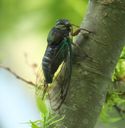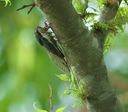Lyric Cicada
Neotibicen lyricen
Classification
- Phylum: Arthropoda
- Subphylum: Hexapoda
- Class: Insecta
- Order: Hemiptera
- Suborder: Auchenorrhyncha
- Infraorder: Cicadomorpha
- Superfamily: Cicadoidea
- Family: Cicadidae
- Subfamily: Cicadinae
- Tribe: Tacuini
- Genus: Neotibicen
- Species: lyricen
Pronunciation
How to pronounce Neotibicen lyricen: //niːoʊˈtɪbɪsɛn ˈlɪrɪsɛn//
These audio files are automatically generated. While they are not always 100% accurate, they are a good starting point.
Images






Summary
Neotibicen lyricen, commonly known as the Lyric Cicada, is a widely distributed cicada species across the eastern United States. It is characterized by substantial polymorphism in coloration and patterning. It shows variability across subspecies, with notable forms like the Coastal Lyric Cicada (ssp. virescens) being much less variable.
Physical Characteristics
Lyric Cicadas are approximately 2 inches or slightly more in total length. They have dark brown/reddish-brown legs, which may occasionally show green hues in tenerals. The pronotum features a well-developed black pronotal collar and may exhibit various coloration patches, including green, bronzy-green, bronze, reddish-brown, brown, or black. They have dark eyes that can appear black/brown or dark greenish-black when teneral. A well-developed ventral black stripe on the abdomen is common among genders and color variants. Males have reddish-tan oblique opercula.
Identification Tips
Observe the color, pattern, and size, though these attributes may vary due to individual variation, geographic origin, and gender. Key identification features include the pronotal collar color, eye color, and the presence of the distinctly ventral black stripe.
Habitat
Can be found in a variety of habitats including coastal scrub, upland deciduous forests, and scattered forests along rivers in the eastern Great Plains, often in association with deciduous hardwoods.
Distribution
Widespread across the eastern USA, from the Midwest and Great Lakes region east to New England, and south to Texas and Florida. Specifically, it is noted in habitats across the Southeast (Gulf Coast), upper Mid-South Appalachia, and mid-Atlantic to New England.
Diet
Adults feed on the sap of hardwood trees such as Pecan, Hickory, Walnut, Wild Cherry, and Apple. Nymphs feed on sap from tree roots.
Life Cycle
Nymphs emerge on hardwood trees, burrowing into the soil and feeding on roots for several years. Final instar nymphs emerge to become winged adults, with emergence potentially occurring at night or during the day.
Reproduction
Eggs are laid in dead wood or twigs, usually preferring dead wood. Unlike some related taxa, they do not typically oviposit in living twigs.
Evolution
The species is polymorphic, displaying significant variation in color, pattern, and size across its geographic range. The current classification of subspecies is debated and may reflect a clinal variation rather than distinct races.
Similar Taxa
Misconceptions
Often confused with Tibicen tibicen due to overlapping characteristics and individual variability.
Tags
- cicada
- Neotibicen lyricen
- Lyric Cicada
- hemiptera
- insects